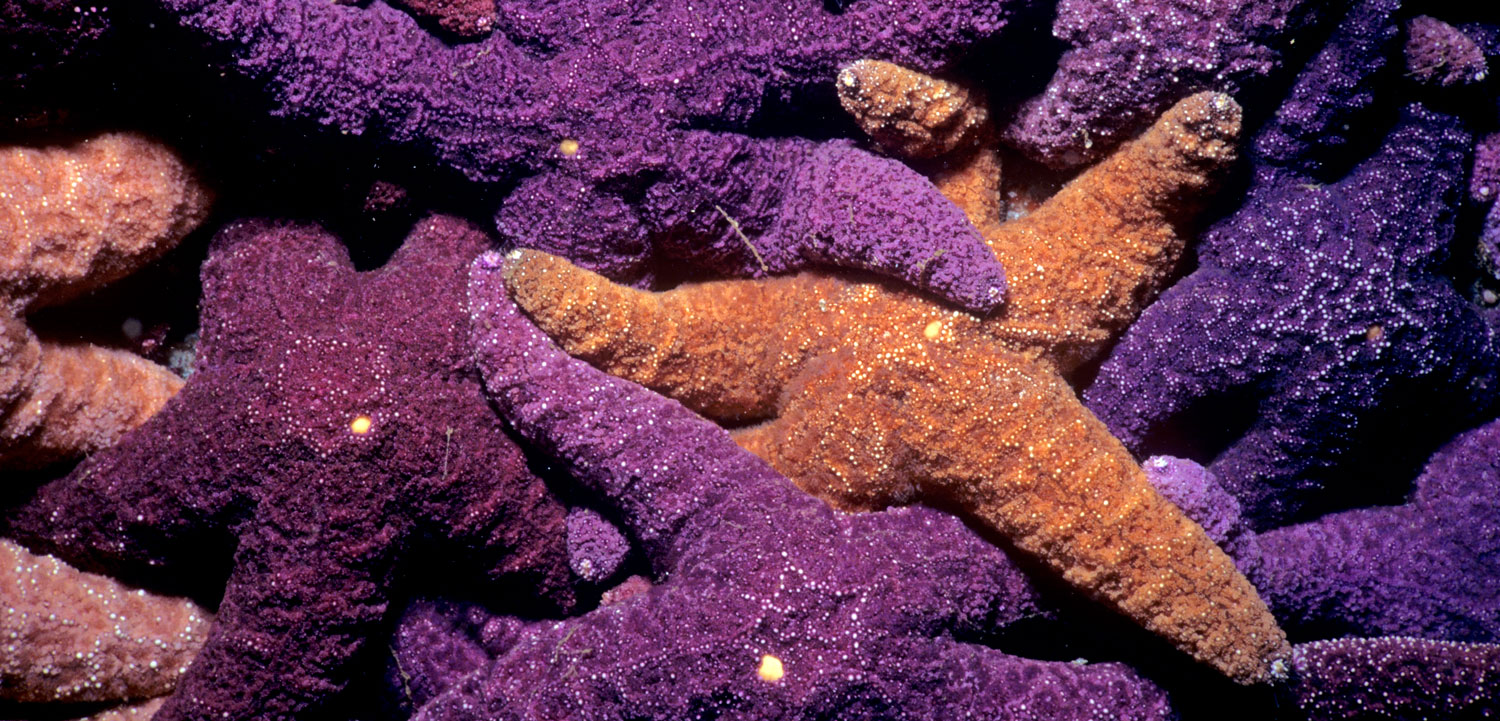Mutant Sea Stars Can Take the Heat
A mutation conferring higher heat tolerance is common among survivors of sea star wasting disease.
Article body copy
Sea stars are basically nature’s own X-Men. Some species have the ability to regenerate, growing a whole new body from a severed limb. But on the west coast of North America, a newly identified mutation is giving some sea stars a whole new power—one that may help them survive long into the future.
Starting in 2013, sea stars off the west coast of North America began to die in huge numbers. A warm water blob was sitting off the coast, throwing the ecosystem into turmoil. Among the victims, sea stars from 20 different species were melting into goo. Researchers believe that the unusually warm water makes them more susceptible to a virus that has been affecting the animals—though to a far lesser degree—for at least 72 years. In some areas that had been heavily populated by sea stars, the animals were pushed to the edge of extinction. The epidemic was named sea star wasting disease, and as it spread, it soon became the largest marine animal die-off in recorded history.
Four years later, the epidemic is waning. The disease persists, though to a lesser degree, and at most sites populations have yet to recover.
Yet there’s an intriguing tendency among the survivors discovered recently by University of Georgia zoologist John Wares and undergraduate student Katelyn Chandler. One species, the ochre sea star, is repopulating the Washington coast. And in these sea stars, the researchers identified a genetic mutation that seems to help the animals survive in warmer water.
The mutation was present in roughly half of the sea stars sampled, but because the study was conducted after the disease had already decimated sea star populations, it’s unknown how common the mutation was before the outbreak.
Sadly, Chandler passed away prior to the publication of the study, but Wares says she was a wonderful student who earned her lead authorship. “Through creative discussion and intellectual engagement with the project, to the bench work … Katelyn got it,” he says.
Wares began studying sea star genetics in 2008, in an effort to understand their often-remarkable coloration. In the process, he discovered the unusual and unexpected mutation to a protein that is generally associated with various cellular “housekeeping” activities, such as helping amino acids bond together. In those earlier trials, Wares discovered that the mutation, a tweak to a protein known as EF1A, seemed to give sea stars a higher level of disease tolerance.
A sunflower sea star succumbs to sea star wasting disease in the water off the British Columbia coast. Video by Grant Callegari
Five years later, as the sea star wasting epidemic gripped west coast populations, Wares wondered how the mutation might relate.
In the summer of 2016, Wares had his students, including Chandler, collect 24 ochre sea stars from the water off the coast of the San Juan Islands in Washington State. They sequenced the sea stars’ genes, and isolated the half that carried the genetic mutation. Then, over an eight-day stretch, they experimented on the sea stars, exposing them to higher water temperatures.
“At the end of that time, we examined how each individual had changed its physiology,” says Wares. Ochre sea stars without the EF1A mutation struggled to adapt. Sea stars with the mutation seemed unfazed by the warmer water.
Ware believes the mutation to EF1A lends the sea stars a higher tolerance for warmer ocean temperatures. The lower level of stress gives them more of a chance to beat back the densovirus, which is ultimately responsible for sea star wasting disease.
So does the presence of this genetic mutation signal the end of the epidemic?
Well, there are some caveats. Wares only studied ochre sea stars, and only at one site. Other formerly widespread sea star species, such as the sunflower sea star, are not seeing the same resurgence. Wares is cautious to extrapolate his study to other populations, and says the next step is to study other species of sea stars.
Cornell University microbiologist Ian Hewson, who first identified the densovirus responsible for sea star wasting disease, thinks the threat has not yet passed. He says the link between warm water and sea star wasting disease isn’t clear-cut. In the wild, he says, “animals that were already exhibiting disease symptoms died faster when they were placed into warmer waters, and conversely slower when in cooler waters. But they all died.”
Even if the mutation does confer some benefit, it might be too little, too late.
“History has told us that when a species like this gets knocked out often it has a hard time returning, since other species fill its ecological niche,” says Hewson.
But Wares is more optimistic. “I think we can at least breathe again, because we are starting to see juveniles and young adults in the intertidal,” says Wares. “But it’s going to take quite a while … for us to know whether we’ve recovered the same abundances and diversity.”

